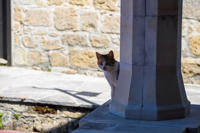Holy Monastery of St Nicholas of the Cats
Cyprus, an island in the eastern Mediterranean, is known for its stunning beaches, historic sites, and charming towns. But nestled in the city of Limassol is a unique attraction that tells a fascinating story about cats, snakes, and a medieval monastery.
The Holy Monastery of St Nicholas of the Cats is a historic site that has been standing since the 4th century. The monastery has undergone several constructions and renovations over the years, but its most remarkable story dates back to its origins.
According to legend, in 327 AD, Saint Helena, the mother of the Roman Emperor Constantine the Great, commissioned the construction of the monastery. However, the builders faced a problem that almost led to the project's abandonment: a plague of venomous snakes that had infested the island, making it almost impossible to work.
To save the day, Saint Helena came up with an ingenious solution: to bring in cats from Persia and Egypt to control the snake population. She had a thousand felines shipped to the island, and after some training, they became the monastery's protectors, responding to two bells: one for feeding and the other for hunting.
The cats' efforts reportedly left them with battle scars, missing eyes, and noses, but they had successfully eradicated the snake infestation, making it possible for the construction of the monastery to be completed.
The Holy Monastery of St Nicholas of the Cats continued to thrive over the centuries, with the cats becoming an integral part of the monastery's identity. They even became an unofficial sub-breed known as the "Cyprus cat," with their distinct physical features and personality traits.
However, in the 1980s, the monastery faced a new challenge: the cats had dwindled in numbers, and a new infestation of snakes had emerged. The church grounds were no longer the safe haven that they once were, and the sisters who now ran the monastery knew what needed to be done.
In an echo of Saint Helena's actions centuries before, the nuns brought in more cats to the monastery. This move was not just for practical reasons, but also to honor the centuries of service that cats had provided to the monastery. They also started taking in stray cats that were brought to them by locals, ensuring that the felines would always have a home.
Today, visitors can explore the Holy Monastery of St Nicholas of the Cats and learn about its unique history. The monastery's architecture is a blend of Byzantine and Gothic styles, with frescoes and icons dating back to the 11th and 12th centuries. The monastery's museum also displays artifacts and religious relics that give visitors insight into the site's long history.
But the real stars of the show are the cats that roam the monastery's grounds. Visitors can interact with these friendly felines and even adopt them if they so choose. The monastery has become a haven not just for spiritual seekers, but also for cat lovers who want to experience the unique charm of the Cyprus cat.
In conclusion, the Holy Monastery of St Nicholas of the Cats is a unique attraction that tells a story of ingenuity, resilience, and the enduring bond between humans and animals. Its history is a testament to the power of cats in controlling vermin populations and the value of preserving cultural traditions that have been passed down through the centuries. For those visiting Cyprus, a trip to this monastery is a must-see, and a chance to experience the island's rich history and natural beauty in a truly unforgettable way.
General Information
Ratings
Spectacular
2
Fantastic
6
Enjoyable
8
Average
2
Terrible
0
3.4


